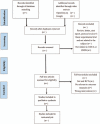Ursodeoxycholic acid after common bile duct stones removal for prevention of recurrence: A systematic review and meta-analysis of randomized controlled trials
- PMID: 30407311
- PMCID: PMC6250542
- DOI: 10.1097/MD.0000000000013086
Ursodeoxycholic acid after common bile duct stones removal for prevention of recurrence: A systematic review and meta-analysis of randomized controlled trials
Abstract
Introduction: The recurrence rate of common bile duct stones (CBDS) after removal has been reported to exceed 10% and no established pharmacologic treatment exists for the prevention of recurrent CBDS. Many studies indicated ursodeoxycholic acid (UDCA) has the potential to prevent the recurrence of CBDS. The aim of this systematic review is to evaluate the effects of UDCA for prevention of recurrence after common bile duct stones removal.
Methods and analysis: We will systematically screen all randomized controlled trials (RCTs) published through electronically and hand searching. The following search engines including Ovid Medline, EMBASE, Cochrane CENTRAL, Proquest, Scopus, Web of Science, Pubmed, the Chinese Biomedical Literature Database, the China National Knowledge Infrastructure, VIP Information, Wanfang Data. Supplementary sources will be searched including gray literature, conference proceedings, and potential identified publications in OpenGrey.eu and Google Scholar databases. Two reviewers will independently conduct the trial inclusion, data extraction and assess the quality of studies. The recurrence rate of CBDS will be assessed as the primary outcomes. The adverse event that required discontinuation of UDCA intervention and the drop-outs (lost to follow-up) before the end of the study will be measured as secondary outcomes. Methodological quality will be evaluated according to the Cochrane risk of bias. All analyses will be applied by RevMan (version 5.3).
Results: This systemic review and meta-analysis will evaluate the effects of UDCA for prevention of recurrence after CBDS removal in RCTs.
Conclusion: Our study will provide evidence to judge whether UDCA is an effective intervention to prevent the recurrence after CBDS removal.
Conflict of interest statement
The authors have no conflicts of interest to disclose.
Figures
References
-
- Neuhaus H, Feussner H, Ungeheuer A, et al. Prospective evaluation of the use of endoscopic retrograde cholangiography prior to laparoscopic cholecystectomy. Endoscopy 1992;24:745–9. - PubMed
-
- Saltzstein EC, Peacock JB, Thomas MD. Preoperative bilirubin, alkaline phosphatase and amylase levels as predictors of common duct stones. Surg Gynecol Obstet 1982;154:381–4. - PubMed
-
- Lacaine F, Corlette MB, Bismuth H. Preoperative evaluation of the risk of common bile duct stones. Arch Surg 1980;115:1114–6. - PubMed
-
- Houdart R, Perniceni T, Darne B, et al. Predicting common bile duct lithiasis: determination and prospective validation of a model predicting low risk. Am J Surg 1995;170:38–43. - PubMed
Publication types
MeSH terms
Substances
LinkOut - more resources
Full Text Sources


